Original URL: https://www.theregister.com/2007/12/13/review_amd_radeon_hd_3850/
AMD ATI Radeon HD 3850 graphics chip
AMD back on top
Posted in Channel, 13th December 2007 11:01 GMT
Review The AMD ATI Radeon HD 3850 uses the same chip as the HD 3870 with the core and memory clock speeds reduced from 775MHz and 2250MHz to 668MHz and 1650MHz. But the really big difference is the 600MHz gap in the memory speed because AMD has chosen to run the 3850 on 256MB of GDDR 3 while the 3870 gets 512MB of the Full Monty GDDR 4.
Apart from the clock speeds you get the same features in both chips: DirectX 10.0 - it'll do 10.1 when 10.1 becomes available - the bus is PCI Express (PCIe) 2.0; an integrated Universal Video Decoder (UVD) core handles HD movie content; the HD audio processor supports HDMI 1.1; and the power connector is a single six-pin PCIe unit instead of the six-pin plus eight-pin found on the Radeon HD 2900 XT.
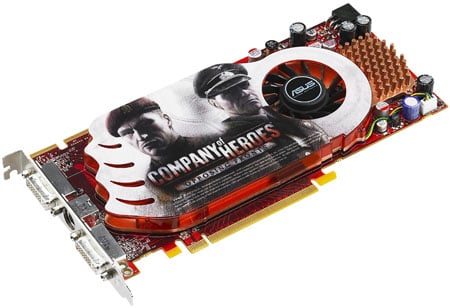
Asus' EAH3850 TOP: powerful yet slim
That’s great when you’re looking at the 3870 as it replaces the 2900 as AMD’s top graphics product so the reduction in power draw and the addition of the UVD make it look quite interesting. The problem is that 3870 can't compete with Nvidia’s top-notch chips so it's been priced at £170 where it can go head-to-head with the GeForce 8800 GT. This is a fair contest, won by the Nvidia product, albeit by a short head.
As we said, the 3850 uses the same technology as the 3870 but it has been positioned as a budget product that uses a single-slot cooler that makes it look very similar to the 2600 XT. If we compare the specification of the 2600 XT and the 3850 there are a fair few similarities as both chips have a UVD, a single power connector and are priced around the £100 mark. The use of PCIe 2.0 is neither here nor there at present, and support for DirectX 10.1 is all well and good but doesn’t have any impact at all for the time being.
The major change is inside the chip as the 2600 was a cut-down version of the 2900 so it only had 120 unified-shader processors compared to the 320 in the 2900, but the 3850 has the full complement of 320.
The result is that the 3850 has 80 per cent of the performance of the 3870 for about 60 per cent of the cost. Gang up two 3850s in CrossFire and you’ll very likely find that the drivers let the side down but when things work properly you’ll have 30 per cent more performance than the 3870 for 25 per cent more expenditure or, to put it another way, for about the same price as a new Nvidia GeForce 8800 GTS.
3DMark06 Results
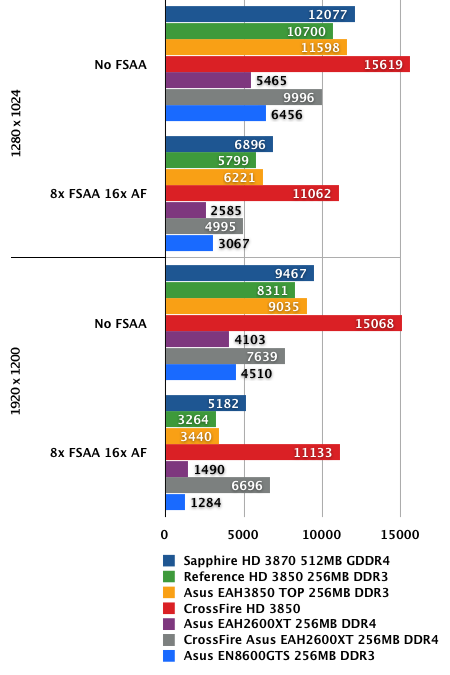
Longer bars are better
Frankly, we’d advise you to steer well clear of CrossFire for the time being although we can’t wait to see CrossFire X in operation early in 2008. In theory, it’ll be great to gang up three or four 3850 cards, but in practice we’ll believe it when we see it. We just hope that CrossFire X forces AMD to properly sort out CrossFire so it runs on two cards without a hitch.
Crysis Results
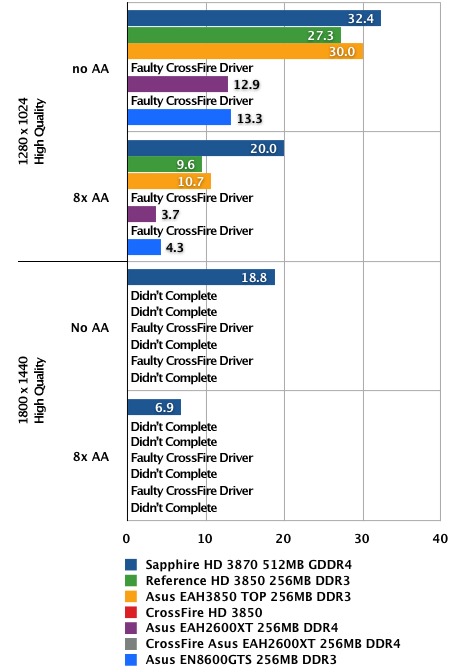
Frames per second
Longer bars are better
Let’s ignore CrossFire and look at the 3850 in isolation starting with a comparison of this factory overclocked Asus TOP model with the reference 3850. Asus includes a copy of Company of Heroes: Opposing Fronts in the box, but more importantly it raises the clock speeds from 669MHz and 1650MHz to 730MHz and 1900MHz.
FEAR: Extraction Point Results
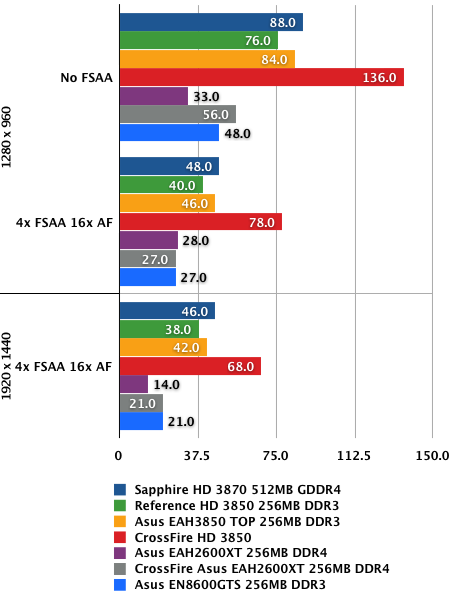
Frames per second
Longer bars are better
The result is a graphics card that delivers 90 per cent of the performance of a stock 3870 right up to the point where the 256MB of memory becomes a limitation. So if you fancy using high levels of anti-aliasing you might be in for a disappointment, but the rest of us will be in clover. This really shows in Crysis at 1280 x 1024 on High Quality settings, where the game is perfectly playable without anti-aliasing although the frame rate drops by two thirds with 4x AA enabled. Higher resolutions in Crysis are beyond the 3850 but we’re dead impressed that you can play Crysis at decent settings on what is, to all intents and purposes, a budget graphics card. No doubt it helps that our test system uses a quad-core Intel Core 2 Extreme QX9650 processor, but, even so, the 3850 is doing its part.
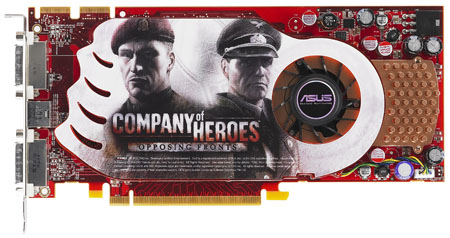
Budget winner?
We gave the 3850 a quick run against its predecessor, the 2600 XT, and chose an Asus model that has 256MB of ultra-fast GDDR 4 memory, but the comparison was absurd. The 2600 XT sells for £80 but was eclipsed by the £105 reference 3850, which actually had better performance than a pair of 2600s in CrossFire. The Asus HD 3850 TOP opens the gap even wider, so while we quite liked the 2600 XT it has most definitely passed its sell-by date.
Thermal and Power Results
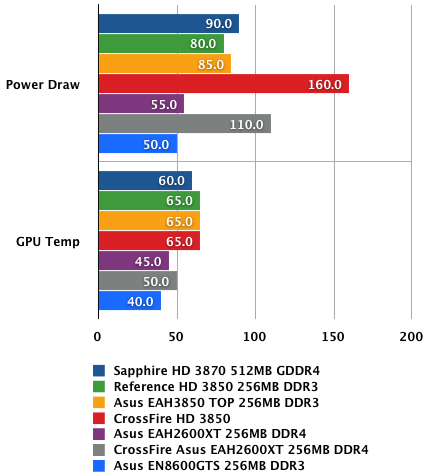
Temperate in °C, power draw in Watts
As Nvidia rules the high-end of the gaming market with the GeForce 8800 GTX and has the upper mid-range tied up with the G92-chipped 8800 GT and 512MB 8800 GTS, the question is how the HD 3850 compares at the £100 price point. Let’s take the Asus EN8600GT, which sells for £99 and which has 256MB of GDDR 3 memory just like the 3850. The comparison could hardly be more fair yet the AMD card destroys the 8600 GTS in every test. The only thing that counts in Nvidia's favour is its card's power draw: 50W compared to the 80W required by the 3850.
Now ask yourself, are you likely to spend £100, £200 or £300 on a new graphics card? A hundred quid gets you a standard 3850, £200 scores you an 8800 GT and £300 is what it costs for an 8800 GTX, so AMD ‘only’ wins in one segment but it’s the most important segment in the gaming graphics market by a long, long way.
Verdict
AMD’s new ATI Radeon HD 3850 sets an incredibly high standard for £100 graphics cards and that has to be good news for the casual gamer who demands value for money.